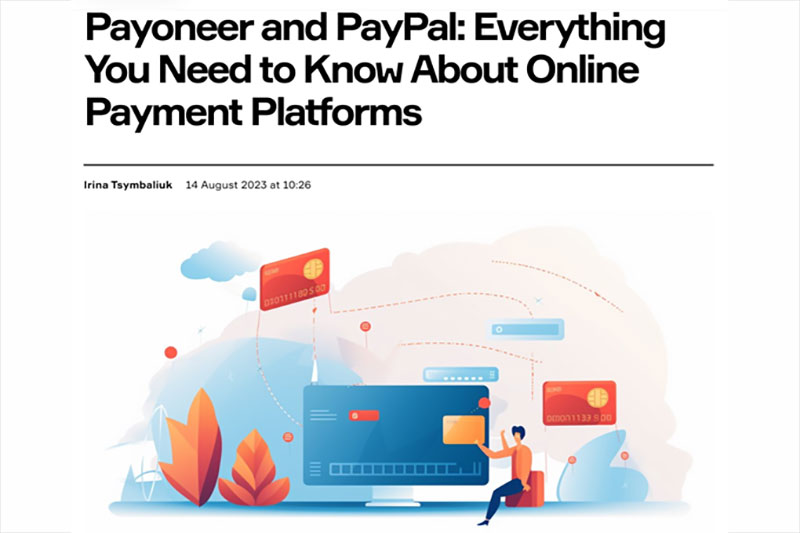With the advancement of IT technology, online payments have become an integral part of Americans’ lives. It is now easy to buy coffee, transfer money, run an online business, or manage cryptocurrency portfolios — all available in a couple of clicks. Every year, online payment systems are becoming more convenient and secure. For example, Chase Bank now has support for digital wallets such as Apple Pay, Google Wallet, and its own Chase Pay. To make a payment, simply tap your phone on a payment terminal or use the appropriate function in the bank’s mobile app. ? How fast are wire transfers with Chase? In 1-2 business days domestically and in 3-5 days for international transactions. After reading this text, you’ll understand how online payment systems impact life through one example — the speed of online transactions.
List of popular online payment systems:
- Authorize.net — best overall ranking.
- PayPal — the best for sending and receiving payments.
- Google Pay — best for holding multiple payment methods.
- Amazon Pay — best for a streamlined checkout process.
- Dwolla — best for third party integration.
- Stripe — best for customization.
- Helcim — for in-person transactions. Helcim vs Stripe: Key Differences — read more at Rates.
- Braintree — best for high volume sales: supports all major credit and debit cards as well as PayPal, Venmo, and other.
- WePay — for quick deposits.
- Chase Pay — for pioneering innovation in digital payments.
- Payoneer — best for global business transactions, offering a multi-currency account that simplifies payments and supports growth in over 190 countries.
The statistics trends: in 2022, the U.S. Federal Reserve processed 3.37 billion commercial checks worth $8.9 billion. At the same time, the total transaction volume in the digital payments market is expected to reach $11.55 trillion by 2024. This forecast reflects the growing demand for convenient and fast digital payment solutions. This is especially true for the younger generation, which is actively engaging in the process of digitalization of business, analysts from McKinsey concluded.

Mobile payments and contactless technology
Not all Americans are ready to abandon traditional methods of financial transactions in favor of online transactions — about 10-15% still hold conservative views. The main obstacles for them are security and privacy issues. However, cell phones have long since become not only a means of communication, but also convenient wallets that allow you to buy goods or manage your investments with the touch of a finger — that’s how fintech works. Contactless technologies such as NFC simplify and speed up this process. Successful mobile payment systems like Apple Pay and Google Wallet demonstrate that even skeptics can be open to innovation. Banks, including Chase Bank, are increasing confidence in online payments by using modern authentication methods, such as biometrics, to ensure security. It is also important how quickly banks transfer money — this is where Chase Bank provides expeditious wire transfers.
Cryptocurrency, blockchain and artificial intelligence
Fintech offer a whole new approach to finance. Blockchain provides transparency and security in data storage, while cryptocurrencies offer freedom from centralized financial institutions. Examples of the use of cryptocurrencies in transactions and blockchain in banking demonstrate the potential of these technologies. Cryptocurrency volatility and regulatory issues remain obstacles, but stable coins and state-owned digital currencies offer solutions. Experts believe that cryptocurrencies and blockchain can radically change the financial system, while regulation and technological innovation can help stabilize the market.
The intersection of cryptocurrency, blockchain, and AI in fintech
- Technology Integration: Taking Chase Bank as an example, the bank is actively embracing cryptocurrency and blockchain technology. While the bank does not offer direct cryptocurrency investment services through its interface, it does approve the transfer of dollars to regulated brokerages.
- Buying Cryptocurrencies: Chase customers can purchase Bitcoin, Ethereum and other cryptocurrencies through recognized digital exchanges in the United States.
- Policy Changes: Effective October 16, 2023, Chase implemented a policy prohibiting payments related to crypto assets.
- Investing in the crypto industry: Contrary to this, Chase Bank remains among those financial institutions that are investing in blockchain companies and projects. They follow 55% of the world’s largest banks investing in the digital currency and blockchain sector, whether directly or through third-party projects, according to Blockdata.
Artificial intelligence and machine learning
The next step after contactless payments, cryptocurrencies and blockchain, which are already integrated into online payment platforms, is the application of artificial intelligence (AI) and machine learning (ML). These technologies are revolutionizing online payment systems by making them more intelligent, personalized and predictable. Their main objective is to fight fraud and improve customer experience by paying attention to individual needs.
How it works:
- Data analytics: AI and ML analyze large volumes of transaction data to identify patterns and predict customer behavior.
- Fraud detection: Systems can detect unusual patterns that may indicate fraudulent activity and respond quickly.
- Personalization of offers: Banks are using AI to create personalized financial offers based on customers’ purchase history and preferences.
Convenience and a personalized approach is what many customers value the integration of AI and IoT into banking for. It’s also the answer to conservative customers who may be worried about the security of their data: intelligently advanced security methods such as biometrics should gain their trust.
In summary
AI, ML, blockchain and contactless technologies are changing the structure of online payments, making them more secure and convenient. Chase Bank’s adoption of cryptocurrency and blockchain signals a tipping point. The integration of AI and IoT enhances the customer experience, streamlines operations and speeds up transactions. How quickly will bank transfers be processed using Chase as an example? This synergy marks a leap in financial technology to complete transactions in minutes. For a deeper understanding of how artificial intelligence and IoT are being integrated into online payment platforms, read Cointelegraph‘s article on how IoT-based payment gateways are transforming banking and payments.









